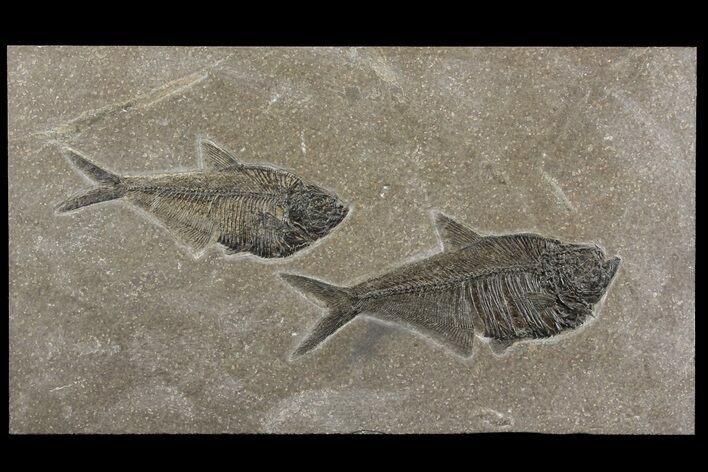This Specimen has been sold.
13" Plate With Two Fossil Fish (Diplomystus) - Wyoming
This is a pair fo jet black, Diplomystus dentatus preserved on a 13 x 7.4" slab of shale from the Green River Formation of Wyoming. The preservation is different than you typically see from the formation as this comes from a hard cap layer that isn't as frequently collected. The fish are beautifully detailed and measure 6.4" and 5.6" long
This specimen includes a display stand.
This specimen includes a display stand.
About Diplomystus
Diplomystus is an extinct genus of freshwater, ray-finned predators that are distantly related to modern herrings and sardines. Diplomystus has a distinctive jaw that protrudes aggressively outward from the mouth at an angle that allowed it to feed in surface waters and devour such prey as the smaller, schooling Knightia.
50 million years ago in the Eocene (55.8 mya to 33.8 mya), D. dentatus thrived in lakes fed by the Uinta and Rocky Mountain highlands. D. dentatus is uniquely entombed in the fine-grained lime mud of Fossil Lake.
The anoxic conditions at the bottom of Fossil Lake slowed bacterial decomposition, prevented scavengers from disturbing corpses, and, most interestingly, suffocated creatures that ventured into the oxygen-starved aquatic layer. The result is a miraculous exhibition of Eocene biota in a subtropical aquatic community within sycamore forests, teeming with creatures such as freshwater stingrays, dog-sized horses, menacing alligators, early flying bats, and one of the first primates.
By the end of the Eocene, Earth developed icehouse climate characteristics and had a change in atmospheric chemistry. The effects of bolide impacts may also have contributed to the eventual loss of flora and fauna at once verdant latitudes.
Today the wonderfully preserved fossils of Diplomystus and other Fossil Lake fauna are collected in several private quarries around Kemmerer, Wyoming. The best preserved fish fossils come from the coveted 18 Inch Layer. This layer is collected at night under high-powered lights, enhancing the faint signs of fish under the surface indicating underlying fossils. These “ghosted” fish then must go through many hours of manual preparation to remove the overlying rock and reveal the Green River fauna in all of its glory.
Diplomystus is an extinct genus of freshwater, ray-finned predators that are distantly related to modern herrings and sardines. Diplomystus has a distinctive jaw that protrudes aggressively outward from the mouth at an angle that allowed it to feed in surface waters and devour such prey as the smaller, schooling Knightia.
50 million years ago in the Eocene (55.8 mya to 33.8 mya), D. dentatus thrived in lakes fed by the Uinta and Rocky Mountain highlands. D. dentatus is uniquely entombed in the fine-grained lime mud of Fossil Lake.
The anoxic conditions at the bottom of Fossil Lake slowed bacterial decomposition, prevented scavengers from disturbing corpses, and, most interestingly, suffocated creatures that ventured into the oxygen-starved aquatic layer. The result is a miraculous exhibition of Eocene biota in a subtropical aquatic community within sycamore forests, teeming with creatures such as freshwater stingrays, dog-sized horses, menacing alligators, early flying bats, and one of the first primates.
By the end of the Eocene, Earth developed icehouse climate characteristics and had a change in atmospheric chemistry. The effects of bolide impacts may also have contributed to the eventual loss of flora and fauna at once verdant latitudes.
Today the wonderfully preserved fossils of Diplomystus and other Fossil Lake fauna are collected in several private quarries around Kemmerer, Wyoming. The best preserved fish fossils come from the coveted 18 Inch Layer. This layer is collected at night under high-powered lights, enhancing the faint signs of fish under the surface indicating underlying fossils. These “ghosted” fish then must go through many hours of manual preparation to remove the overlying rock and reveal the Green River fauna in all of its glory.
About Fossil Lake
50 million years ago, in the Eocene epoch, these fish thrived in Fossil Lake, which was fed by the Uinta and Rocky Mountain highlands. The anoxic conditions at the bottom of Fossil Lake slowed bacterial decomposition, prevented scavengers from disturbing corpses, and, most interestingly, suffocated creatures that ventured into the oxygen-starved aquatic layer. The result is a miraculous exhibition of Eocene biota: a subtropical aquatic community within sycamore forests, teeming with creatures such as freshwater stingrays, dog-sized horses, menacing alligators, early flying bats, and one of the first primates.
50 million years ago, in the Eocene epoch, these fish thrived in Fossil Lake, which was fed by the Uinta and Rocky Mountain highlands. The anoxic conditions at the bottom of Fossil Lake slowed bacterial decomposition, prevented scavengers from disturbing corpses, and, most interestingly, suffocated creatures that ventured into the oxygen-starved aquatic layer. The result is a miraculous exhibition of Eocene biota: a subtropical aquatic community within sycamore forests, teeming with creatures such as freshwater stingrays, dog-sized horses, menacing alligators, early flying bats, and one of the first primates.
SPECIES
Diplomystus dentatus
LOCATION
Kemmerer, Wyoming
FORMATION
Green River Formation
SIZE
Fish 6.4" & 5.6", Rock 13 x 7.4"
CATEGORY
SUB CATEGORY
ITEM
#158598
We guarantee the authenticity of all of our specimens.
 Reviews
Reviews














